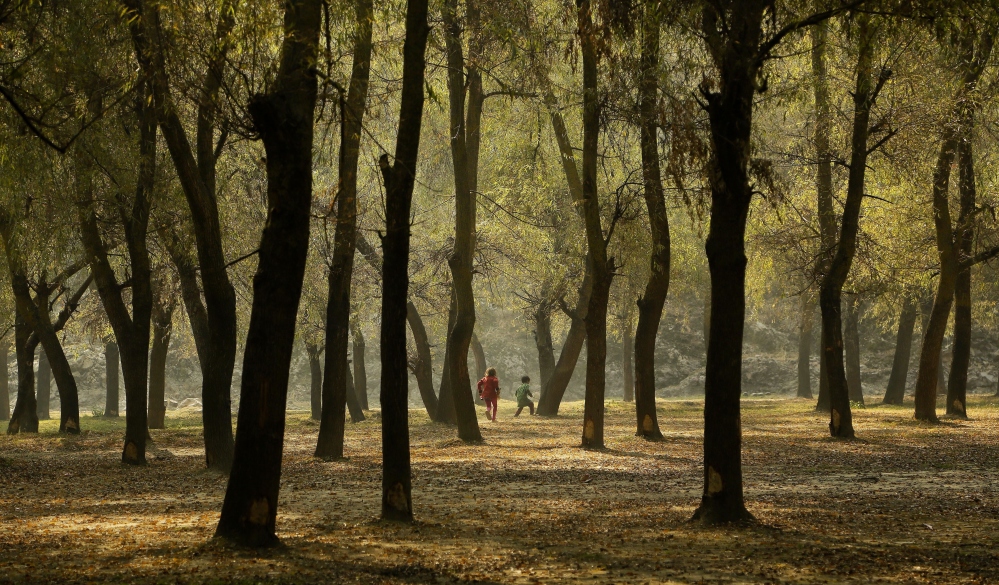WULAR LAKE, India — Tucked within Kashmir’s Himalayan foothills sits a freshwater lake that was once among Asia’s largest. Long an inspiration to poets, beloved by kings, Wular Lake has been reduced in places to a fetid and stinking swamp.
Just the sight of it makes Mohammed Subhan Dar feel sick. He admits he’s partly responsible.
Dar was among dozens of villagers employed in the 1950s by the regional government to plant millions of water-sucking willows in the crystalline lake. The goal had been to create vast plantations for growing firewood and timber for construction and cricket bats. The result was the accidental near-destruction of the lake, as the trees drank from its waters and their tangled roots captured soil and built up the land.
The lake, now less than half of its former capacity, no longer churns and heaves with high waves, but meanders across mossy swamps and trash-strewn backwaters. Children long ago stopped playing in the water. Families no longer use it to cook.
‘IT USED TO BE SO BEAUTIFUL’
“It used to be so beautiful, so clear you could see the bottom. That glory is gone,” said Dar, whose family has lived lakeside for seven generations. He alone planted at least 2 acres of what is now a full-blown willow forest.
“I feel ashamed every day. But it was work,” he said. “We’ve felt so helpless as governments meddled with the lake.”
As Wular lost its appeal, its value declined. Poverty rates in the 31 surrounding villages shot up to around 50 percent – five times the state average.
The authorities “did not realize what they were trading. They were so focused on protecting and growing the forest they lost sight of the lake,” said Rahul Kaul of the nonprofit Wildlife Trust of India, which last year worked on an economic assessment of Wular’s repair.
Kashmir and New Delhi officials now want to fell millions of trees, remove acres of soil and dredge enormous patches of lake bottom. Proposals have been drafted, experts consulted and money pledged, including nearly $1 million already spent tearing up willow forest on the lake’s eastern flank.
But restoring an enormous alpine lake is no simple thing, especially with climate change now threatening the Himalayan glaciers that feed Wular’s waters, and deforestation still unleashing soil to clog it up once more.
Restoring such a lake in Indian-controlled Kashmir – where a decadeslong violent conflict often supersedes all other government plans – may be near impossible.
NAME MEANS ‘STORMY’
The name Wular itself means “stormy” in the local Kashmiri language, and once described the lake’s strong winds and choppy waters. Formed within a deep cavern created by ancient earthquakes, the lake was for centuries considered a paradise by writers, philosophers, nobles and travelers who camped on its banks and reveled in legends of an ancient city that vanished in the 5th century when a massive flood filled in the lake.
Mohammed Azim Tuman remembers a boyhood spent steering his houseboat by moonlight over towering waves.
“My heart would be racing as I clung to the railing to keep from falling into the water,” said Tuman, the elderly proprietor of a tourism business. “When a storm hit, the water would splash so high I thought, ‘My god, the boat will be swallowed whole.’ ”
Back then, Kashmir was still a sleepy principality at the edge of the British Empire. In the seven decades since, India and Pakistan won independence and began fighting over Kashmir, a prolonged separatist conflict has erupted and tens of thousands have been killed.
Today hundreds of thousands of Indian troops hunt for rebels through the cities and countryside. Razor wire snakes across the landscape. Military vehicles trundle along mountain roads.
Wular’s surface lies flat, lifeless and in some spots stagnant, teeming with mosquitoes. The water trickles in from the Jhelum River, and meanders some 10 miles before emptying through a dam on its way toward Pakistan.
The surface and its surrounding marshlands have shrunk from 83 square miles in 1911 to just 40 square miles in 2008. Along the fringes, impoverished communities tend rice paddies and in autumn harvest wild water chestnuts from the lake shallows. The ornately carved wooden houseboats that once surfed Wular’s waves are gone.
Wular’s degraded state has not only ruined its prospects for tourism, but also has compromised the lake’s function in absorbing heavy snow and ice melt from the mountains.
In 2014, Kashmir’s main city of Srinagar, just 21 miles southeast of the lake, was inundated with floodwaters that wreaked billions of dollars in damage. It happened again a few months later in 2015.Wular’s story is a familiar one – a story of development at nature’s expense, of good intentions and profound regret, of wetlands disappearing.
Since 1990, the planet has lost 75 percent of its wetlands as communities drained the water and built on the land. What’s left today offers about $3.4 billion in services including water filtration, flood control and wildlife support, according to a 2010 report for The Economics of Ecosystems & Biodiversity , an ongoing project proposed by the Group of Eight industrialized nations to study monetary values for the environment.
Kashmir’s other losses include Anchar Lake, now almost entirely gone, and the famed Dal Lake in Srinagar, which has lost 70 percent of its capacity.
Send questions/comments to the editors.




Comments are no longer available on this story